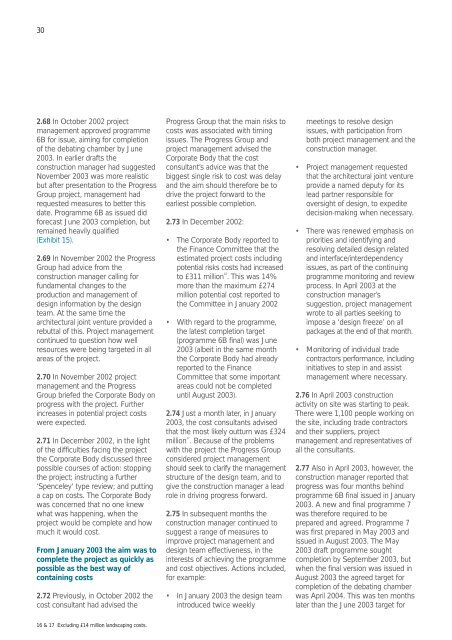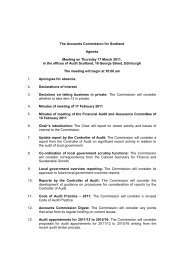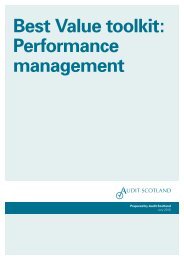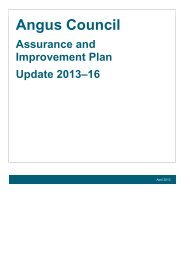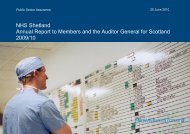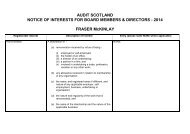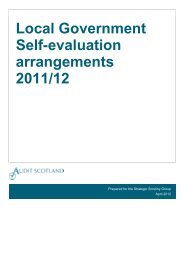Management of the Holyrood building project (PDF ... - Audit Scotland
Management of the Holyrood building project (PDF ... - Audit Scotland
Management of the Holyrood building project (PDF ... - Audit Scotland
You also want an ePaper? Increase the reach of your titles
YUMPU automatically turns print PDFs into web optimized ePapers that Google loves.
30<br />
2.68 In October 2002 <strong>project</strong><br />
management approved programme<br />
6B for issue, aiming for completion<br />
<strong>of</strong> <strong>the</strong> debating chamber by June<br />
2003. In earlier drafts <strong>the</strong><br />
construction manager had suggested<br />
November 2003 was more realistic<br />
but after presentation to <strong>the</strong> Progress<br />
Group <strong>project</strong>, management had<br />
requested measures to better this<br />
date. Programme 6B as issued did<br />
forecast June 2003 completion, but<br />
remained heavily qualified<br />
(Exhibit 15).<br />
2.69 In November 2002 <strong>the</strong> Progress<br />
Group had advice from <strong>the</strong><br />
construction manager calling for<br />
fundamental changes to <strong>the</strong><br />
production and management <strong>of</strong><br />
design information by <strong>the</strong> design<br />
team. At <strong>the</strong> same time <strong>the</strong><br />
architectural joint venture provided a<br />
rebuttal <strong>of</strong> this. Project management<br />
continued to question how well<br />
resources were being targeted in all<br />
areas <strong>of</strong> <strong>the</strong> <strong>project</strong>.<br />
2.70 In November 2002 <strong>project</strong><br />
management and <strong>the</strong> Progress<br />
Group briefed <strong>the</strong> Corporate Body on<br />
progress with <strong>the</strong> <strong>project</strong>. Fur<strong>the</strong>r<br />
increases in potential <strong>project</strong> costs<br />
were expected.<br />
2.71 In December 2002, in <strong>the</strong> light<br />
<strong>of</strong> <strong>the</strong> difficulties facing <strong>the</strong> <strong>project</strong><br />
<strong>the</strong> Corporate Body discussed three<br />
possible courses <strong>of</strong> action: stopping<br />
<strong>the</strong> <strong>project</strong>; instructing a fur<strong>the</strong>r<br />
‘Spenceley’ type review; and putting<br />
a cap on costs. The Corporate Body<br />
was concerned that no one knew<br />
what was happening, when <strong>the</strong><br />
<strong>project</strong> would be complete and how<br />
much it would cost.<br />
From January 2003 <strong>the</strong> aim was to<br />
complete <strong>the</strong> <strong>project</strong> as quickly as<br />
possible as <strong>the</strong> best way <strong>of</strong><br />
containing costs<br />
2.72 Previously, in October 2002 <strong>the</strong><br />
cost consultant had advised <strong>the</strong><br />
16 & 17 Excluding £14 million landscaping costs.<br />
Progress Group that <strong>the</strong> main risks to<br />
costs was associated with timing<br />
issues. The Progress Group and<br />
<strong>project</strong> management advised <strong>the</strong><br />
Corporate Body that <strong>the</strong> cost<br />
consultant’s advice was that <strong>the</strong><br />
biggest single risk to cost was delay<br />
and <strong>the</strong> aim should <strong>the</strong>refore be to<br />
drive <strong>the</strong> <strong>project</strong> forward to <strong>the</strong><br />
earliest possible completion.<br />
2.73 In December 2002:<br />
• The Corporate Body reported to<br />
<strong>the</strong> Finance Committee that <strong>the</strong><br />
estimated <strong>project</strong> costs including<br />
potential risks costs had increased<br />
to £311 million 16<br />
. This was 14%<br />
more than <strong>the</strong> maximum £274<br />
million potential cost reported to<br />
<strong>the</strong> Committee in January 2002<br />
• With regard to <strong>the</strong> programme,<br />
<strong>the</strong> latest completion target<br />
(programme 6B final) was June<br />
2003 (albeit in <strong>the</strong> same month<br />
<strong>the</strong> Corporate Body had already<br />
reported to <strong>the</strong> Finance<br />
Committee that some important<br />
areas could not be completed<br />
until August 2003).<br />
2.74 Just a month later, in January<br />
2003, <strong>the</strong> cost consultants advised<br />
that <strong>the</strong> most likely outturn was £324<br />
million 17<br />
. Because <strong>of</strong> <strong>the</strong> problems<br />
with <strong>the</strong> <strong>project</strong> <strong>the</strong> Progress Group<br />
considered <strong>project</strong> management<br />
should seek to clarify <strong>the</strong> management<br />
structure <strong>of</strong> <strong>the</strong> design team, and to<br />
give <strong>the</strong> construction manager a lead<br />
role in driving progress forward.<br />
2.75 In subsequent months <strong>the</strong><br />
construction manager continued to<br />
suggest a range <strong>of</strong> measures to<br />
improve <strong>project</strong> management and<br />
design team effectiveness, in <strong>the</strong><br />
interests <strong>of</strong> achieving <strong>the</strong> programme<br />
and cost objectives. Actions included,<br />
for example:<br />
• In January 2003 <strong>the</strong> design team<br />
introduced twice weekly<br />
meetings to resolve design<br />
issues, with participation from<br />
both <strong>project</strong> management and <strong>the</strong><br />
construction manager.<br />
• Project management requested<br />
that <strong>the</strong> architectural joint venture<br />
provide a named deputy for its<br />
lead partner responsible for<br />
oversight <strong>of</strong> design, to expedite<br />
decision-making when necessary.<br />
• There was renewed emphasis on<br />
priorities and identifying and<br />
resolving detailed design related<br />
and interface/interdependency<br />
issues, as part <strong>of</strong> <strong>the</strong> continuing<br />
programme monitoring and review<br />
process. In April 2003 at <strong>the</strong><br />
construction manager’s<br />
suggestion, <strong>project</strong> management<br />
wrote to all parties seeking to<br />
impose a ‘design freeze’ on all<br />
packages at <strong>the</strong> end <strong>of</strong> that month.<br />
• Monitoring <strong>of</strong> individual trade<br />
contractors performance, including<br />
initiatives to step in and assist<br />
management where necessary.<br />
2.76 In April 2003 construction<br />
activity on site was starting to peak.<br />
There were 1,100 people working on<br />
<strong>the</strong> site, including trade contractors<br />
and <strong>the</strong>ir suppliers, <strong>project</strong><br />
management and representatives <strong>of</strong><br />
all <strong>the</strong> consultants.<br />
2.77 Also in April 2003, however, <strong>the</strong><br />
construction manager reported that<br />
progress was four months behind<br />
programme 6B final issued in January<br />
2003. A new and final programme 7<br />
was <strong>the</strong>refore required to be<br />
prepared and agreed. Programme 7<br />
was first prepared in May 2003 and<br />
issued in August 2003. The May<br />
2003 draft programme sought<br />
completion by September 2003, but<br />
when <strong>the</strong> final version was issued in<br />
August 2003 <strong>the</strong> agreed target for<br />
completion <strong>of</strong> <strong>the</strong> debating chamber<br />
was April 2004. This was ten months<br />
later than <strong>the</strong> June 2003 target for


